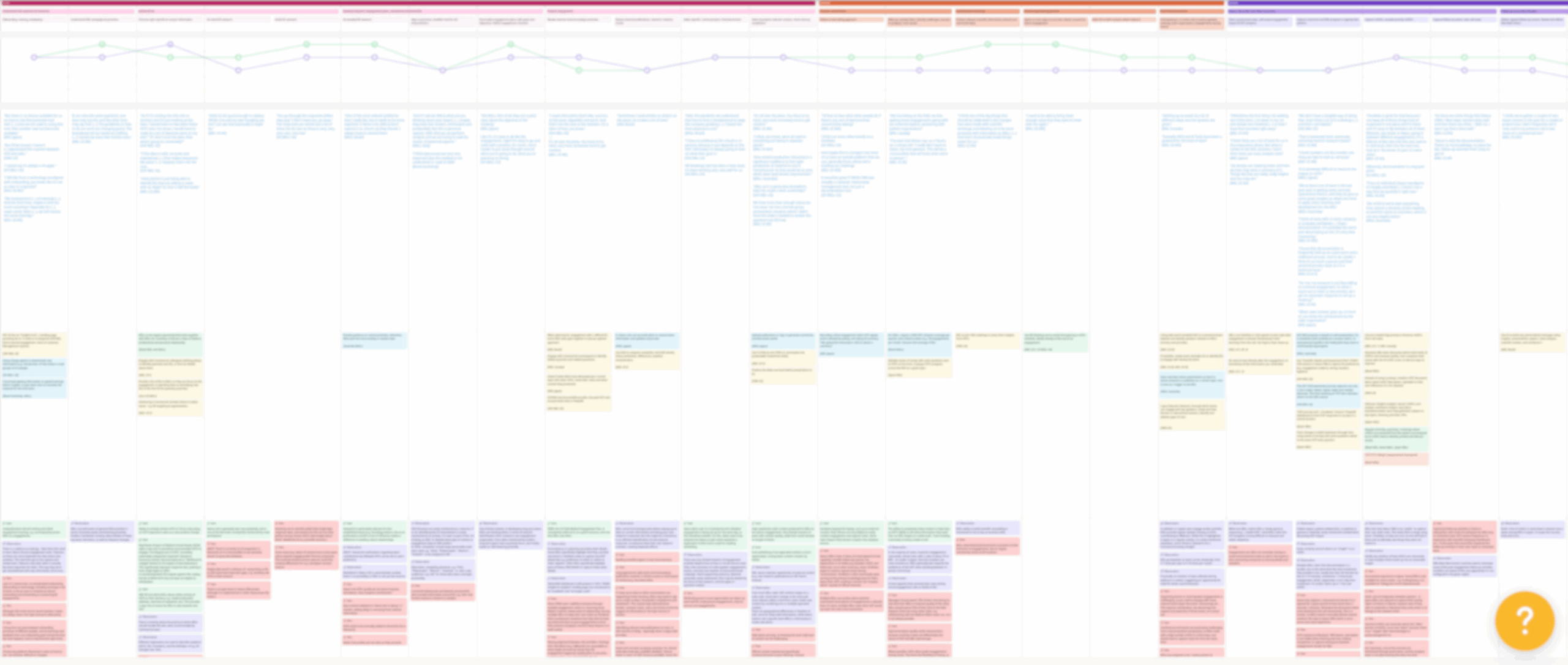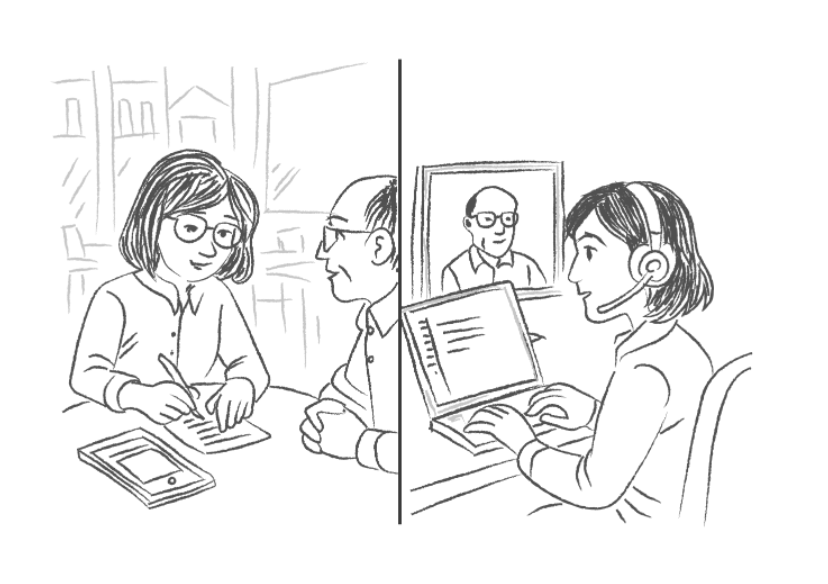Service Design meets stakeholder needs
Turn complexity into memorable takeaways and actions
By Julia Borkenhagen, CXO and Co-founder of Whitespace
Date: 24 July, 2025
Advice for designers on managing stakeholders
You have done extensive research, analyzed, synthesized, and built amazing personas, user journeys, even blueprints — now what?
You need to communicate all this valuable information to your stakeholders and encourage them to take action. But how? As designers, we love complexity… But our stakeholders want clear solutions.
Here is some advice for Service Designers seeking to improve their stakeholder management skills.
This article is based on a talk delivered by Julia Borkenhagen at the annual Swiss Service Design Week event held in May 2025
Start by empathizing with your stakeholders
As designers, we pride ourselves on empathizing with the end users, and for good reason. But we often fail to do the same with our stakeholders. I am the first one to admit it, having produced massive research reports and visualizations over the years. These reports didn't always hit the mark, which got me thinking about stakeholder needs and how to address them.


At Whitespace, we collaborate with a diverse range of stakeholders. During an internal workshop, we conducted a quick mapping of different “client types” ranging from the Engaged Leader to the Know-it-all persona.
Considering the diverse personalities, contexts, and needs of stakeholders, it is crucial to tailor your communication style, tone, and ultimately, your services and deliverables to meet their specific requirements.

While it’s useful to have an idea of different client or stakeholder personas, there are some fundamental truths about your stakeholders that are worth considering:
-
- They lack time
Stakeholders are, above all, pressed for time: their agendas are packed with back-to-back meetings, inboxes and chats are flooded, and they can’t find space for deep work. - They need just enough information
Stakeholders are in a constant state of information overload and require just enough data to make informed decisions. - They care about the business impact
Stakeholders primarily care about the business impact, whether it is cost savings or revenue increase. - They need to demonstrate value
Stakeholders need to hit or exceed their KPIs, do their own PR, and look good in front of their peers and management.
- They lack time
So, once we have empathized with our stakeholders, where are the opportunities? To find out, let's dive a little deeper into these stakeholder truths, shall we?
1. Be mindful of people's time
If you are new to a project, try to understand what happened before. Are stakeholders frustrated with previous (maybe unsuccessful) attempts to fix the problem? Do they have interview and or workshop fatigue? What can be learned from the past, and how can we build on existing learnings?
Whether stakeholders are frustrated or willing to engage, they will appreciate it if you can find innovative ways to avoid long and frequent meetings or workshops. Consider whether a live discussion or brainstorming session is truly essential for the topic at hand, or if asynchronous collaboration could achieve the desired outcome.
When you have secured that precious time for a live session, make it count. Be prepared, share pre-reads or viewpoints in advance (a video walk-through can do wonders!), and make the time spent together fun and productive.
2. Simplify
Mark Twain famously said, “I didn't have time to write a short letter, so I wrote a long one instead.”
Simplicity is hard, especially with complex subjects, but not everyone needs the same level of detail.
Stakeholders don't have time for complex blueprints or multiple user journeys. They need highlights, "the drama," and storytelling.
Strategies include:
- Telling a story with dramatic impact, e.g., the worst possible scenario
- Illustrating user journeys visually (hand-drawn preferred), focusing on key pain points/insights tied to opportunities/recommendations
- Creating a comprehensive one-pager
This does not negate the need for complex artifacts. They remain crucial reference points for the team during specification and implementation.

Using a journey mapping tool such as JourneyTrack is a great way to manage all the insights. It allows for easy filtering and drilling down without losing oversight. While a great working tool for the project team, it would be completely overwhelming for stakeholders, who need a higher-level summary.
Here we have a summarized version that was used during a workshop to discuss the pain points and opportunities.

Using hand-drawn sketches is another powerful way to illustrate the activities and sentiments. In this case, we also created a video narration to fully immerse the audience and help them empathize with the persona.




3. Speak their language
I mentioned earlier that stakeholders are usually interested in business impact. They may care about the users’ needs, but in the end, it is all about “optimization” and “growth” – reducing costs, increasing revenues. What can you do? Speak their language. I have found “de-risking” to be a great argument for doing more research or early prototyping. 🙂
Here are a couple of examples of how to translate Designer needs into Business needs:
| Designer speak | Stakeholder speak |
|---|---|
| We should do more research. | Investing in user research helps de-risk the project by validating assumptions early and avoiding costly rework later. |
| We want to improve usability. | Improving usability increases efficiency, reduces support costs, and accelerates adoption. |
| Let's test this with users before we build. | Early user testing helps us avoid spending time and money on features that won’t deliver value. |
| We want to understand user needs. | By aligning the product with real user needs, we can increase customer satisfaction and drive retention. |
| The flow is confusing. | Friction in the user journey can lead to drop-offs, longer task times, and increased operational burden. |
| We should co-create with users. | Engaging end-users early helps build buy-in and reduces resistance to change during the implementation process. |
| We should simplify this interface. | A simplified interface shortens onboarding time and reduces training and support costs. |
| We're designing for edge cases. | By accounting for critical scenarios and exceptions, we reduce operational risk and ensure compliance. |
4. Turn insights into actions
Yes! The research report is finally complete, and it even looks quite professional. You have presented it to the steering committee, and people were duly impressed. Now what? How can the research have an impact beyond show and tell? And how can your stakeholders demonstrate the value they are seeking? The truth is, building actionable insights starts much earlier in the journey. Here are a few tips I have collected over the years.

Design your research with the end goal in mind
Before you begin your collaborative journey, it's essential to align on shared goals and desired impact. Are you conducting pure discovery research, or is your aim to enhance an existing workflow? Is the problem clearly defined, or is it overly vague or broad? What are the potential outcomes and applications of this research?
Understanding this context is paramount. For instance, if your stakeholders require the research to build a business case, the results should be more visionary in nature. Conversely, if the purpose is to offer tactical recommendations for an already budgeted upcoming release, the outcomes can be more granular.

Bring your stakeholders along on the journey
Yes, they are pressed for time, but keeping stakeholders engaged and interested throughout will build trust and confidence.
If interviews are not "sensitive" and interviewee privacy is not a blocker, creating short “highlight reels” can amplify the voice of the customer. Participating in well-organized, outcome-focused workshops will make them feel heard and give a sense of ownership. Additionally, a brief weekly newsflash from the research and design team can help address “impatient” stakeholders who would like to see insights immediately.

Identify the “low-hanging fruit”
Stakeholders are often skeptical of research unless it shows value quickly. Identifying and acting on low-hanging fruit — simple improvements with high impact — shows that research isn’t just academic; it drives change and helps bridge the gap between insight and action.
Creating these “early wins” helps stakeholders who are under pressure to deliver results. An early win from research (e.g., a clearer form, better onboarding) makes it easier to justify deeper and longer-term efforts.

Always visualize your recommendations
Let’s face it: wordy reports are ineffective. Why not use the superpower we have been given? Whenever possible, designers should aim to visualize relationships, causations, flows, and visions.
Visuals serve as a shared language, bridging the communication gap between stakeholders, designers, and engineers who often think and speak in different ways. This shared understanding simplifies grasping problems and aligning on directions.
While many stakeholders may not read a detailed report, they are highly likely to engage with an interface mockup or a high-level flow diagram.

Value-oriented roadmap/action plan
A value-oriented roadmap or action plan is one of the most important outcomes of service design and research because it bridges the gap between insight and implementation. It translates what we’ve learned about user needs, pain points, and systemic challenges into a clear, shared path forward—prioritized by value.
Without a roadmap, insights risk staying abstract and getting lost in strategy decks. A value-oriented roadmap is a joint effort and forces the team to agree on what’s most important to do next, and why. Who is impacted, and what value (to the users AND the business) does this change or feature generate?
Finally, aligning around values, rather than simple features, helps a multi-functional team focus and avoid politics, tunnel vision, and wasted effort.
To sum it all up
When working with stakeholders, it's all about putting yourself in their shoes. You need to respect their time, simplify complexity, speak their language, and translate your findings into actionable steps they can take.
By designing your research with the final goal in mind, involving stakeholders at every step, identifying easy wins, presenting your recommendations visually, and crafting roadmaps that demonstrate real value, you'll ensure that your design work truly makes a difference.
In other words, the best service artifacts don’t just inform — they align, convince, and motivate people to act.




